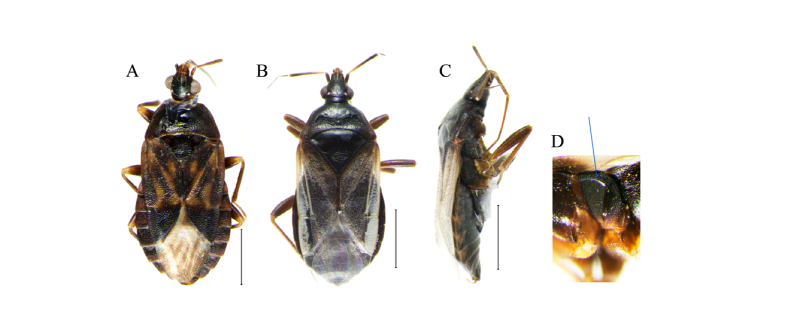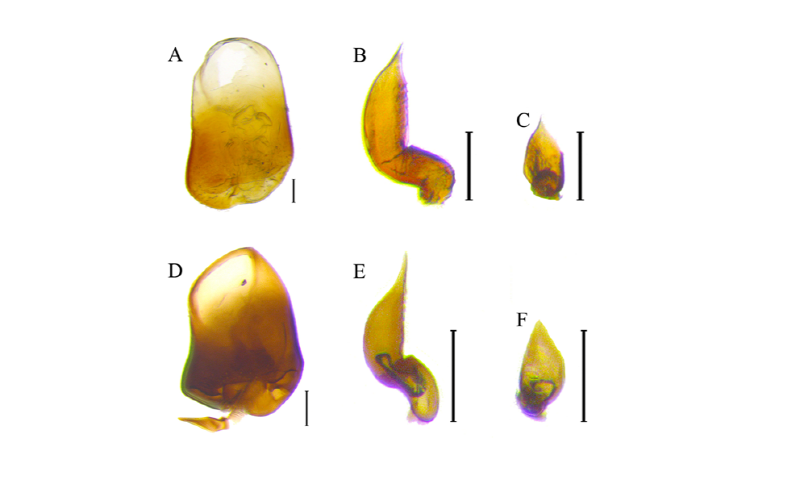Introduction
The family Lyctocoridae (Hemiptera: Heteroptera: Cimicomorpha) is a small group in with general appearance like that of Anthocoridae and Lasiochilidae (Schuh and Slater, 1995). However, this family is recognized from such groups by followed characters: needle-shaped apex of aedeagus of male genitalia and presence of internal apophysis on the anterior margin of seventh abdominal sternum of female (Schuh and Slater, 1995). The type genus, Lyctocoris Hahn, 1835, comprises 27 species distributed mainly in the Northern Hemisphere, with most of the species from the Palaearctic Region (Chu, 1969; Kelton, 1978; Schuh and Slater, 1995; Péricart, 1996; Lattin, 2000). Lyctocoris species are found predominantly in decaying plant materials and under the bark of rotten trees (Kelton, 1967; Lattin, 2000), however they have been seen inhabiting nests of birds and small rodents (tys and Daniel, 1957; Yamada et al., 2012). They are considered to be predominantly predaceous, preying on various small insects and tiny arthropods such as bark beetles (Coleoptera: Scolytidae) and stem borers (Lepidoptera: Pyralidae) (Yamada et al., 2012). Due to their predacious behavior some species are known to control pests in stored food facilities and crops (Hiura, 1957; Chu, 1969). In addition, Lyctocoris campestris has sometimes been confirmed to feed on the blood of humans and domestic animals (Woodward, 1951; Yamada et al., 2012). On the other hand, Yamada et al. (2012) described a new species that reported to feed on Quercus acutissima (Fagaceae) sap, a unique feeding habit within the Lyctocoridae and related families. In this paper, the family Lyctocoridae is reviewed taxonomically with a discovery of new record Lyctocoris ichikawai Yamada & Yasunaga, 2012 to Korean fauna. Description, diagnosis, and biology of each species are presented with photographs. A key to Korean Lyctocoridae species is also provided.
Materials and Methods
Systematic account for the family Lyctocoridae follows Schuh and Slater (1995). Terminology follows mainly Yamada et al. (2012). Depository of examined specimens is at the Laboratory of Systematic Entomology, Chungnam National University, Daejeon, Korea. Countries marked with an asterisk (*) at the distribution subsection of each species corresponds to the first record of the species. Specimens were observed and measured under light stereomicroscope (M165C, Leica, Germany). Measurements are given in millimetres (mm). Male genital segment was extracted and macerated in KOH at 10% at 70ºC for five minutes. Segments where cleaned with distilled water and agglomerate conjunctive tissues were removed manually using entomological needles and placed in slides with Glycerine for image taking. Images were taken in sequential focus in the Leica DMC 2900 and measurements were taken using software program (LAS Interactive Measurements, Leica, Wetzlar, Germany) on the same microscope. After examination, the genital segment was placed in vials filled with glycerine pinned with the corresponding specimen.
Results
Taxonomy
Family Lyctocoridae Reuter
Genus Lyctocoris Hahn
Lyctocoris Hahn, 1836: 19. Type species: Cimex domesticus Schilling, 1834.
Euspudaeus Reuter, 1884: 11. Type species: Anthocoris funebris Motschulsky, 1863.
Nesidiocheilus Kirkaldy, 1902: 127 (syn. Zimmerman, 1948: 184). Type species: Nesidiocheilus hawaiiensis Kirkaldy, 1902.
Diagnosis. Distinguished by labium straight form, exceeding midcoxae or reaching to base of abdomen (Fig. 1C); ostiolar peritreme with distinct L-shaped structure (Fig. 1D); pygophore distinctly asymmetrical; parameres distinctly asymmetrical, left paramere approximately two times longer than right paramere; left paramere tapered to its apex; right paramere tapered to its apex (Fig. 2A-F). See Yamada et al. (2012) for detailed diagnosis for female genitalia.
Lyctocoris ichikawai Yamada & Yasunaga, 2012
(Fig. 1A, 2A-C, and 3)
Lyctocoris ichikawai Yamada et al., 2012: 65.
Diagnosis. Recognized by scutellum almost dark brown except for pale apex; hemelytra dark brown with pale yellow markings; clavus dark brown with pale markings medially; basal and inner part of corium pale brown; cuneus entirely dark brown; membrane with four distinct vein; both sides of left paramere rounded, its apex sharp from subapical part; right paramere tapered to apex subapically, its apex sharp.
Description. See Yamada et al. (2012) for original description.
Genitalia. Pygophore asymmetrical (Fig. 2A); both lateral margins of left paramere rounded, its apex sharp from subapical part, (Fig. 2B); right paramere short, tapered to apex in subapical part, its apex sharp (Fig. 2C).
Measurements (in mm). Male (n = 1)/Female (n = 1): Body length 4.63/4.79; head length (excluding neck) 0.61/0.65; head width (including eyes) 0.84/0.86; vertex width 0.44/0.46; width between ocelli 0.33/0.33; lengths of antennal segments I - IV respectively 0.20/0.21, 0.64/0.65, 0.43/0.43, and 0.50/0.50; lengths of labial segments II - IV respectively 0.37/0.38, 1.05/1.06, and 0.46/0.47; anterior pronotal width 0.59/0.62; mesal pronotal length 0.64/0.65; basal pronotal width 1.66/1.70; length of embolial margin 1.51/1.52; length of cuneal margin 0.84/0.86; maximum width across hemelytra 1.88/1.89.
Specimen examined. [CNU] 1♂1♀, Jikdong-ri, Soheul-eup, Pocheon-si, Gyeonggi-do, Korea, on Quercus acutissima (Fagaceae), 24.vii.2013, W.H. Song leg.
Distribution. Korea*, Japan.
Biology. Both nymphs and adults of this species were found on the trunk surface with sap of Quercus acutissima in central part only (Gyeonggi-do) in the Korean Peninsula. The biology of this species such as feeding habit and life history was well studied by Yamada et al. (2012).
Lyctocoris beneficus (Hiura, 1957)
(Fig. 1B-D and 2D-F)
Euspudaeus beneficus Hiura, 1957: 31; Jung et al., 2013: 425.
Diagnosis. Recognized by the hemelytra transparent with dark brown base; basal third part of clavus brownish; apex of cuneus very narrowly dark brown; one lateral margin of left paramere straight, apex of left paramere long and sharp; apex of right paramere relatively blunt, inwardly bended apex of right paramere.
Description. See Hiura (1957) for detailed original description.
Genitalia. Pygophore asymmetrical (Fig. 2D); left paramere with straight lateral margin and distinctly curved lateral margin, its apex sharp and long (Fig. 2E); right paramere short, its apex relatively blunt (Fig. 2F).
Measurements (in mm). Male (n = 1)/Female (n = 3): Body length 3.87/3.95 - 4.01; head length (excluding neck) 0.48/0.50 - 0.51; head width (including eyes) 0.58/0.59 - 0.60; vertex width 0.31/0.33 - 0.34; width between ocelli 0.27/0.29 - 0.31; lengths of antennal segments I - IV respectively 0.22/0.24 - 0.25, 0.58/0.62 - 0.65, 0.34/0.36 - 0.37, and 0.42/0.45 - 0.46; lengths of labial segments II - IV respectively 0.34/0.35 - 0.36, 0.71/0.72 - 0.74, and 0.35/0.37 - 0.38; anterior pronotal width 0.47/0.49 - 0.51; mesal pronotal length 0.42/0.44 - 0.45; basal pronotal width 1.27/1.29 - 1.32; length of embolial margin 1.24/1.26 - 1.29; length of cuneal margin 0.65/0.68 - 0.70; maximum width across hemelytra 0.65/0.67 - 0.69.
Specimen examined. [CNU] 3♀♀, Yongmoon-san (Mt), Sinjeom-ri, Yongmoon-myeon, Yangpyeong-gun, Gyeonggi-do, Korea, 13.vii.2009, S. Jung leg.; [CNU] 1♂, Doan-dong, Seo-gu, Daejeon, Korea, 8.viii. 2014, H.D. Lee leg.; [CNU] 1♀, Gung-dong, Yuseong-gu, Daejeon, Korea, light trap, 31.vii.2015, J. Kim leg.; [CNU] 1♂3♀♀, Miwon-myeon, Sangdang-gu, Cheongju-si, Chungcheongbuk-do, Korea, Light trap, 2.viii.2015, J. Kim leg.
Distribution. China, Japan, Korea, Russia (Far East).
Biology. This species is associated with the piles of fire wood and grass (e.g., Miscanthus sinensis (Poaceae)), and feeds on rice stem borer, Chilo suppressalis (Lepidoptera: Pyralidae), in the stacks of rice-plant straw (Hiura, 1967; Jung et al., 2013). This species is usually attracted by artificial light trap near streams or ponds.
Remarks. Whitish pale anterior margin of hemelytra of the specimens examined in Korean population is sometimes variable in coloration (Fig. 1B).
Key to the Korean Lyctocoridae species
1. Hemelytra blackish brown with pale markings, membrane transparent with dark patterns, left paramere tapered to apex subapically.............................................................................................................................................................................L. ichikawai
1’. Hemelytra almost transparent without any markings, membrane entirely transparent, left paramere tapered to apex in middle ....................................................................................................................................................................................L. beneficus
Conclusion
The family Lyctocoridae is a relatively small cimicomorphan group, but this group is also one of the important groups to resolve phylogenetic relationship in Cimicoidea. Here, this family is reviewed with a finding of one newly recorded species from the Korean Peninsula, and with investigations of morphological information such as variation of important character. This study can provide morphological data such as detailed illustrations, and biological data for future taxonomic and systematic study of this unexplored group.







